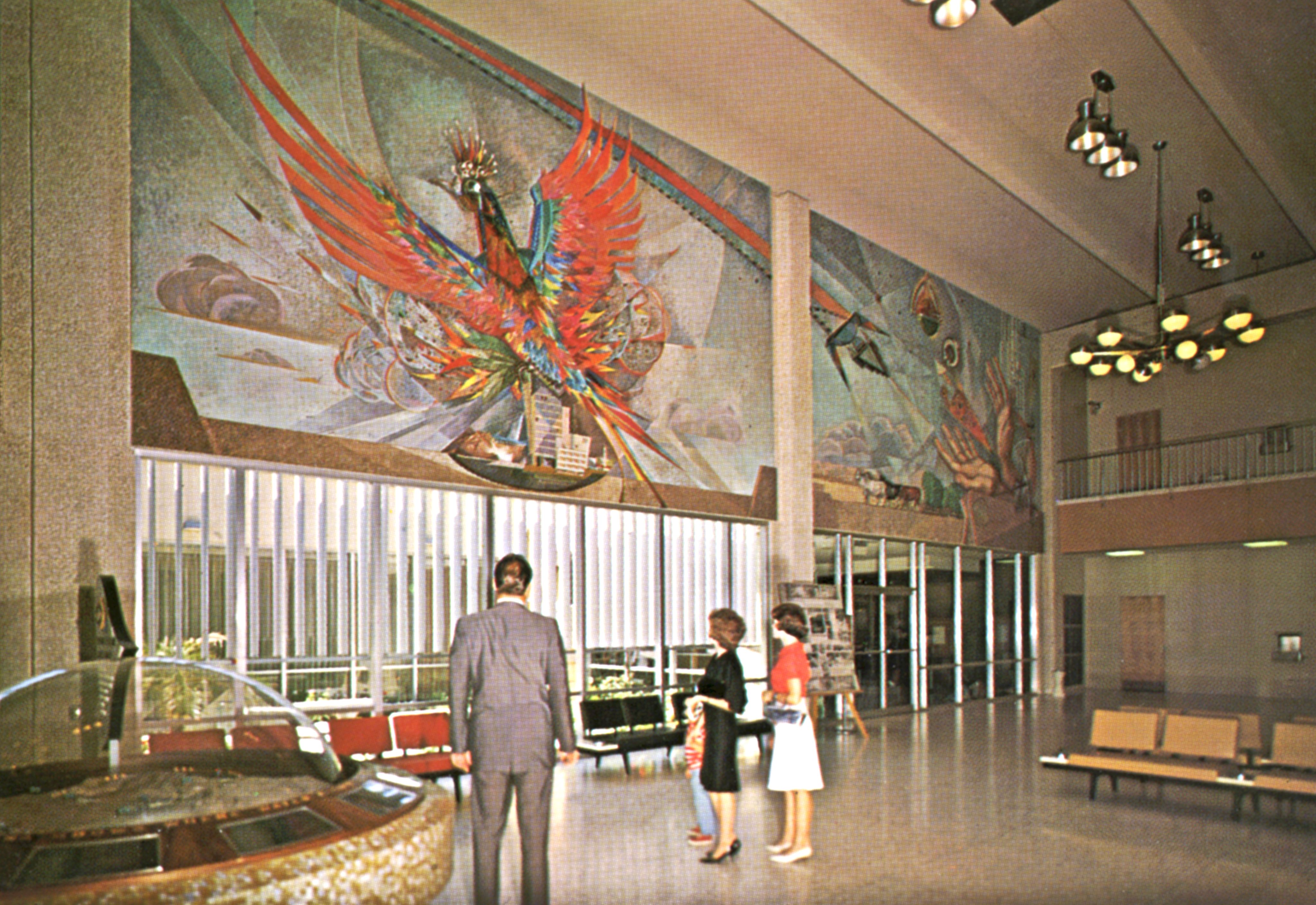Rental Car Center Museum Exhibitions
Rental Car Center Exhibitions
View the Rental Center Art Guide
The Making of The Phoenix Mural
Through October 2022

"The Phoenix" mural by Paul Coze, located on level 3 at the Rental Car Center

Paul Coze and Kay Coze creating The Phoenix mural, 1962, image courtesy of
Location
-
Rental Car Center, level 3
Overview
An iconic city landmark, The Phoenix is considered the first piece of public art commissioned by the City using a general process. Drawings by five artists were put on display at the Phoenix Public Library in 1960, and citizens voted for their favorite design, ultimately choosing Paul Coze’s design. The 75-foot-wide mural consists of three panels depicting Phoenix and Arizona’s proud past, dynamic present, and bright future:
Earth (left panel) pays tribute to the first pre-historic inhabitants (the Hohokam) as well as modern tribes and Latino heritage. The “Mormon Battalion” is also represented along with wagon trains, railroads, and cattle ranching.
Water and Fire (center panel) is dominated by a blazing Phoenix, a mythical bird, perched atop a native date palm. Smoke from the ashes forms clouds whose moisture is collected by Roosevelt Dam, making modern life possible in the Valley of the Sun, providing water for farmland and power for homes produced by the Dam.
Air (right panel) honors Arizona’s history and beckons Arizona’s future. Outstretched hands reach toward skies filled with both modern and historical symbols. The state’s legacies of agriculture, ranching, and mining also are represented.
The Phoenix is a mixed-media artwork comprised of 52 different materials. Included are traditional art-making materials such as paint and charcoal and non-traditional items such as plastics, shells, and semi-precious stones. The artist even included sand and soil from locations around Arizona. He created the mural by painting and embellishing fifteen canvases with various materials and then attached them to the wall. The variety of materials makes the mural dimensional and one of Arizona’s most unique and treasured public-art pieces.
The Most Modern Air Terminal
Through October 2022

Terminal 2 lobby, 1962
Overview
Phoenix Sky Harbor, the sixth busiest airport in the nation in 1962, was ready for the jet age with the opening of its ultra-modern terminal. With the advent of larger aircraft powered by turbine engines, air travel became more affordable. The new jet airliners could go faster, higher, and further and carry more people than the older prop planes. At four times the size of Sky Harbor’s Terminal 1, the new $2.7 million East Terminal (later known as Terminal 2) provided everything needed to accommodate the growing number of travelers taking to the skies.
The state-of-the-art facility included numerous amenities, conveniences, and innovations that we take for granted today, such as automatic doors, baggage carousels, a lighted parking area, and ramps rather than steps. Airport visitors dined, shopped for gifts, played pinball, bought flowers, and even got a haircut at the many concessions edging the main lobby.
The sleek new Terminal 2 was as beautiful as it was efficient. The open and spacious terminal was designed in the mid-century modern style as “a symphony in cement, steel, glass, and marble.” Expansive glass curtain walls with stained-glass pillars, thirty-foot high ceilings, and exposed concrete columns and beams all reflected the modern and clean aesthetic of the time. The Phoenix by Paul Coze, the iconic 75-foot-wide mural, graced the entire east wall of the lobby, welcoming visitors for years to come.
Phoenix planners in the 1960s predicted that Terminal 2 and its future expansion would meet air travel needs until the year 2000. Passenger usage tripled in less than 10 years and building additional terminals became necessary in the 1970s and the 1980s. Today, Sky Harbor continues to expand and build to keep pace with the dynamic growth of today’s commercial aviation industry. Known as The Most Modern Air Terminal in the nation when it opened, the now undersized Terminal 2 closed in early 2020.
Stories of a Local Community: Paintings by Frank Ybarra

Frank Ybarra, Swimming in the Canal, 2009, acrylic on canvas
Overview
Each of these paintings by local artist Frank Ybarra illustrates stories gathered from former residents of neighborhoods surrounding Phoenix Sky Harbor International Airport. These communities, known as Golden Gate and Barrios Unidos (United Neighborhoods), were home to primarily Latino families.
The illustrations commemorate their everyday activities as well as special occasions and celebrations. They represent stories of love and pride, church and family, work, and play. Quinceañeras, swimming in canals, dancing at local ballrooms, picnicking in the parks, and the music at Sunday Mass are all reminders of the rich culture of a local community.

